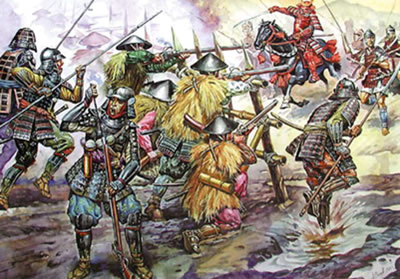 |
| Battle of Sekigahara |
The Battle of Sekigahara was fought between the forces of Tokugawa Ieyasu and those of his opponents. His decisive victory ensured his appointment as shogun of Japan and the establishment of the Tokugawa Shogunate that ruled Japan until 1868.
By mid-16th century, the Ashikaga Shogunate of Japan was in terminal decline and civil wars raged in the land as rival nobles or daimyo sought to replace it. The second of the powerful lords, Toyotomi Hideyoshi (1535–98), almost accomplished the task.
As he neared death, and with his son Hideyori too young to exercise power, he appointed a council of five regents to rule on the boy’s behalf, hoping that they would checkmate one another. Tokugawa Ieyasu was one of the regents.
  |
Ieyasu had helped Hideyoshi in his campaigns and had been rewarded with extensive landholdings in the agriculturally rich Kanto Plain area where he had built a formidable castle at the port of Edo (modern Tokyo). Ieyasu did not participate in Hideyoshi’s attempted conquest of Korea, remaining in Japan to consolidate his holdings.
The balance of power among the five regents soon dissolved with four of the five regents aligning against Ieyasu. An adroit politician, Ieyasu was able to crack the formidable coalition by securing the secret support of many of the lords ostensibly loyal to the other regents, who moreover were rivals of one another.
The showdown occurred on October 21, 1600, at the Battle of Sekigahara. Ieyasu won decisively, partly through to the defection of some of his opponents’ forces. The victory made him military master of Japan. Eighty-seven daimyo houses were extinguished, the remainder, including Toyotomi’s fief, dramatically reduced, allowing Ieyasu to expand the land he directly controlled and to reward his supporters.
In 1603, the emperor acknowledged the fait accompli by appointing Ieyasu shogun. He would consolidate his power during his remaining years with laws that secured obedience to the surviving daimyo and by retiring in 1605 in favor of his son, while remaining behind the scenes to ensure the stability of the shogunate.
In 1614, he launched a final massive campaign, mobilizing 180,000 troops against Hideyori at his stronghold, Osaka castle, defended by 90,000 men. The castle was taken and Hideyori was killed. These two campaigns ensured the supremacy of the house of Tokugawa.